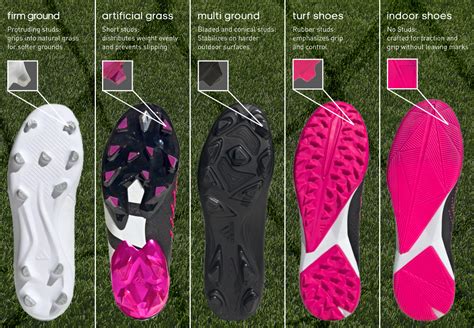As a soccer player, selecting the right cleats can dramatically enhance your performance and enjoyment on the pitch. Grass soccer cleats provide optimal traction, stability, and support for navigating the challenges of natural grass surfaces. This comprehensive guide will empower you with the knowledge to make informed decisions when choosing grass soccer cleats tailored to your specific needs.

Understanding the Anatomy of Grass Soccer Cleats
Upper:
-
Materials: Cleat uppers are typically constructed from leather, synthetic materials, or a combination of both. Leather offers durability and comfort but requires maintenance, while synthetics are lightweight and water-resistant.
-
Design: Uppers feature various designs, including low-cut, mid-cut, and high-cut, which influence ankle support and mobility.
Sole:
-
Studs: Grass soccer cleats have conical studs designed to grip the ground and prevent slipping or sliding. Stud patterns and configurations vary to accommodate different playing styles and surfaces.
-
Material: Soles are typically made from TPU (thermoplastic polyurethane) or nylon, offering durability and cushioning.
Key Factors to Consider When Selecting Grass Soccer Cleats
Playing Surface:
- Grass surfaces vary in length, density, and moisture levels. Choose cleats with appropriate studs to match the specific type of grass field you will be playing on.
Playing Style:
-
Speed: Players who prioritize acceleration and agility may opt for lightweight cleats with shorter studs.
-
Control: Midfielders and defenders require stability and control. Cleats with longer studs provide enhanced traction for pivoting and changing direction.
-
Power: Strikers need cleats that maximize shot power and accuracy. Cleats with firm studs provide a solid base for kicking.
Fit:
-
Soccer cleats should fit snugly without causing discomfort. Allow for slight room in the toe box to prevent blisters.
-
Consider the width of your feet. Cleats come in various widths to accommodate different foot shapes.
Recommended Grass Soccer Cleats
Based on extensive research and expert reviews, here are some highly rated grass soccer cleats:
Nike Phantom GT2: Renowned for its excellent ball control and striking power.
Adidas X Ghosted.3: Lightweight and agile, designed for speed and acceleration.
PUMA Ultra Ultimate: Ultra-responsive and comfortable, providing exceptional touch and control.
Benefits of Grass Soccer Cleats
Enhanced Traction: Grass soccer cleats provide superior grip, reducing the risk of slipping or sliding on natural grass surfaces.
Increased Stability: Cleats with firm studs stabilize your feet, facilitating quick changes of direction and improved balance.
Reduced Injury Risk: By providing support and stability, soccer cleats help reduce the likelihood of ankle sprains and other foot-related injuries.
Improved Performance: The right grass soccer cleats can enhance your agility, speed, and overall performance on the pitch.
Types of Grass Soccer Cleats
Molded Cleats: Permanently attached to the sole, providing consistent traction in all directions. Suitable for most grass surfaces.
Detachable Cleats: Allow players to customize the stud pattern and length to suit specific playing conditions. Ideal for varying grass surfaces.
Hybrid Cleats: Combine detachable studs with a soft ground sole, offering a balance of traction and comfort. Suitable for both grass and artificial surfaces.
Taking Care of Your Grass Soccer Cleats
Clean Regular: Use a damp cloth to wipe away dirt and debris. Remove studs and clean them separately if necessary.
Dry Thoroughly: Air-dry your cleats after use. Avoid using artificial heat sources, as this can damage the materials.
Replace Studs: Regularly inspect studs for damage or wear. Replace worn or broken studs to maintain optimal traction.
Frequently Asked Questions
What is the best type of stud pattern for grass soccer cleats?
- The ideal stud pattern depends on the grass surface and playing style. Round studs provide good traction in all directions, while conical studs enhance stability.
How often should I replace my grass soccer cleats?
- Cleats should be replaced every 6-12 months, depending on usage and playing conditions.
Can I use grass soccer cleats on artificial turf?
- No, grass soccer cleats are designed specifically for natural grass surfaces. Using them on artificial turf can damage both the cleats and the surface.
Conclusion
Grass soccer cleats are essential gear for any soccer player looking to optimize their performance on the pitch. By understanding the anatomy, key factors, and types of grass soccer cleats, you can make informed decisions that will enhance your traction, stability, and overall playing experience. Remember to consider the playing surface, playing style, fit, and maintenance tips discussed in this guide to make the most of your grass soccer cleats.
